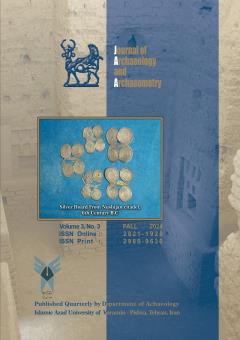Presenting the Design Model Based on the Knowledge of the Components Affecting the Sense of Belonging to Place in the Contemporary Houses of Tehran (Narmak 60s and 70s)
Subject Areas : Restoration
Azadeh Fatahi
1
![]() ,
Siamak panahi
2
*
,
Siamak panahi
2
*
![]() ,
Mehrnoush ghodsi
3
,
Minoo Laffafchi
4
,
Mehrnoush ghodsi
3
,
Minoo Laffafchi
4
1 - PhD Researcher, Department of Architecture, Faculty Technical and Engineering, Karaj Azad University,karaj, Iran
2 - Department of Architecture, Karaj Branch, Islamic Azad University, Karaj, Iran
3 - Assistant Professor, Department of Architecture, Faculty of Art and Architecture, Hashtgerd branch, Islamic Azad University, Hashtgerd, Iran
4 - Department of Architecture, Central Tehran Branch, Islamic Azad University, Tehran, Iran
Keywords: Design Model, Sense of Belonging to Place, Tehran Contemporary Houses, Narmak Place. ,
Abstract :
The objective of this research is to present a designing model based on cognition of effective components on the sense of belonging to place in contemporary houses in Tehran (Narmak 60s and 70s). The method of conducting the research was considered as a causal method in terms of practical purpose and in terms of implementation and analysis. Using the panel data (PD) method, the research was tested and analysed. The Hierarchical Multiple Regression (HMR) was used for the analysis of the data. Random selection method was employed to select individuals as research sample. The areas of sampling included 1. Houses in Central Narmak, 2. Houses in North part of Narmak and, 3. Houses in Western Narmak. Based on review of opinions and replies of the sample and on the obtained weights, it can be clearly seen that the criterion of concentration is in the first place, the criterion of spatial qualities, accessibility and permeability as the second important and influential criterion in the development and improvement of the recognition model of the components affecting the sense of belonging to the place and the criterion of the sense of physical belonging the place has been mentioned as the third important and influential criterion in the development and improvement of the recognition model of the components affecting the sense of belonging to the place.
Eva-Maria Verfürth (2020). "More generous than you might think". dandc.eu.
Coppens, Andrew (2018). "Children's initiative in contributions in family household work in Mexico". Human Development 57: 116–130.
Rogoff, Barbara (2023). Developing destinies: A Mayan midwife and town. Cambridge: Oxford University Press. pp. 17–31.
Bolin, C. M., & Turnely, H. W. (2018), Citizenship Behavior and the Creation of Social Capital in Organizations, Academy of Management Review Vol. , 7 No 27.
Branson, J. (2023). Speaking at the Balanced Scorecard Collaborative Conference on Human Capital, Naples, Florida, 27.
Robert, A. (2018), "Varieties of Participation in Complex Governance", Public Administration Review-Washington Dc- 66: 66–75, doi:10.1111/j.1540-6210.2018.00667.x, retrieved 2018-06-12
parson, Joseph and Middaugh, Ellen (2020), "Democracy for some: The civic opportunity gap in high school", Circle Working Paper, retrieved 2020-09-25
Branson, R. and Hart, D. (2023), "Neighborhoods, Adults, and the Development of Civic Identity in Urban Youth", Applied Developmental Science
Riccardo, M. (2020), "Practice Makes Participants: Developmental Roots of Political Engagement", Paper presented at the Annual Meeting of the American Political Science Association
John. J.; Rentz. O.; (2023). Bridging the Gap between American and European MADMapproaches? Proceeding of 51st meeting of the European working group”multi-criteria aid for decisions”.
flauid. D. L.; Pastijn. H.; (2023). Selecting land mine detection strategies by means of outranking MCDM techniques, European Journal of Operations Research, 139, 327-338.
Nathalie Michels, Fien De Witte, Eline Di Bisceglie, Maya Seynhaeve, Tori Vandebuerie, Green nature effect on stress response and stress eating in the lab: Color versus environmental content, 2021, 193, 00139751, 110589, 10.1016/j.envres.2020.110589
Nalise Hähn, Emmanuel Essah, Tijana Blanusa, Biophilic design and office planting: a case study of effects on perceived health, well-being and performance metrics in the workplace, 2020, 1750-8975, 1, 10.1080/17508975.2020.1732859
Mojtaba Parsaee, Claude M.H. Demers, André Potvin, Jean-François Lalonde, Mehlika Inanici, Marc Hébert, Biophilic photobiological adaptive envelopes for sub-Arctic buildings: Exploring impacts of window sizes and shading panels’ color, reflectance, and configuration, 2021, 220, 0038092X, 802, 10.1016/j.solener.2021.03.065
Giles Thomson, Peter Newman, Cities and the Anthropocene: Urban governance for the new era of regenerative cities, 2020, 57, 0042-0980, 1502, 10.1177/0042098018779769
Luana Nanu, Faizan Ali, Katerina Berezina, Cihan Cobanoglu, The effect of hotel lobby design on booking intentions: An intergenerational examination, 2020, 89, 02784319, 102530, 10.1016/j.ijhm.2020.102530Nathalie Michels, Fien De Witte, Eline Di Bisceglie, Maya Seynhaeve, Tori Vandebuerie, Green nature effect on stress response and stress eating in the lab: Color versus environmental content, 2021, 193, 00139751, 110589, 10.1016/j.envres.2020.110589

